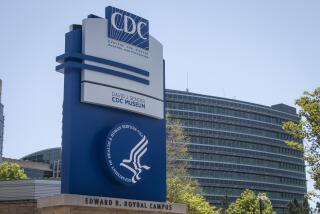Prop. 97 Gives State Task of Restoring Funds for Cal/OSHA
- Share via
California officials Wednesday began the task of doing something that has never been done before in the state--restoring a government program whose funding has been abolished by the governor.
On Tuesday, the state’s electorate by a margin of 54% to 46% approved Proposition 97, which requires Gov. George Deukmejian to restore funding for Cal/OSHA, the state’s private sector worker safety and health program. A. Alan Post, the state’s highly respected legislative analyst from 1949 to 1977, called the action “unique” in California history.
Deukmejian vetoed funding for Cal/OSHA last year, saying that the state would save $8 million and could rely on a comparably effective federal program.
Labor and public health organizations immediately objected, asserting that the state program was vastly superior to the federal one and that the savings were a mere pittance in a $40-billion state budget. After court challenges to the governor’s action bogged down, an initiative campaign was launched.
Proponents of Proposition 97 raised more than $1.5 million. Deukmejian was the sole active opponent, writing the ballot argument against the measure and appearing in television advertisements against it. With the exception of the California Chamber of Commerce, all of the state’s major business organizations, traditionally Deukmejian allies, remained neutral or supported 97. Failure to garner major business support played a key role in Deukmejian’s loss on the issue, Post said.
More Effort Needed
On Wednesday, the governor contended that if he had spent more time fighting 97, it would have been defeated.
But Larry Berg, director of the Institute of Politics at USC, disagreed. “The governor got a message sent to him, as he did on a couple other propositions,” Berg said. “The message to him is he better sit down with the Senate and the Assembly and get about governing. . . . He refused to compromise on this with the Legislature.”
Berg said he felt that the measure was aided by increased public awareness of industrial hazards. He said media reports about recent explosions at the Mobil Oil refinery in Torrance, the chlorine spill that forced thousands of residents to evacuate East Los Angeles communities over Labor Day weekend and cancer clusters in rural Northern California communities heightened that awareness.
John F. Henning, secretary-treasurer of the California Federation of Labor (AFL-CIO), the primary sponsor of 97, said voters responded to arguments that Cal/OSHA’s standards were stronger than the federal agency’s, and that the state had a tougher enforcement program. The federal OSHA stepped into the breach in July, 1987, after the Legislature failed to override Deukmejian’s veto. Cal/OSHA had 21 offices throughout the state, compared to seven opened by the federal government.
Marc Grossman, a spokesman for the pro-97 forces, called the election results “a great victory for labor.”
But Henning said a major reason the measure passed was that pro-97 forces built a broad-based coalition that included the American Cancer Society, the California Medical Assn. and the Sierra Club, in addition to organized labor and its traditional Democratic Party allies.
“The people who worked real hard on this initiative won’t stop working now,” said Fran Schreiberg, a lawyer with the California Building Trades Council. “We built a broad coalition between labor and community, and those bonds are going to continue.”
Los Angeles County Dist. Atty. Ira Reiner said he thought the significance of Proposition 97’s victory “goes beyond the importance of reinstating Cal/OSHA.” He said that the support Proposition 97 got showed that if Democrats campaigned on issues of what he called “market-basket liberalism” rather than “counter-culture liberalism,” they could become a majority party again. “In order to become a majority party, instead of just a congressional party, we have to go back to representing the interests of working men and women.”
Plans to Be Disclosed
At his press conference Deukmejian said that although he was disappointed at the outcome, he would defer to the will of the voters and restore Cal/OSHA. He did not present a timetable to get the agency up and running.
Ronald T. Rinaldi, director of the state’s division of industrial relations, said the Administration’s plans would be revealed in a few days.
Lois Wallace, assistant director of the state Department of Finance, said that “from our reading of the proposition, it’s a current-year issue, something that can’t wait for the next fiscal year,” which begins in July. Wallace said action will have to be taken soon, adding that it is possible the Legislature could amend the current state budget to fund Cal/OSHA when it reconvenes in early December.
In the past, the federal government provided about half of the funding for Cal/OSHA--roughly $14.9 million. Sources said it is possible that the state will try to obtain some of the funding to restart the agency from the federal government.
Under federal law, the Department of Labor has to approve California’s plan to resume the state program. Sources said they did not expect that to be a difficult process. Until a new program is approved, however, federal OSHA will retain jurisdiction for the safety and health of the state’s 9.5 million private sector workers. The state has continued its safety and health program for state and local government workers.
One other problem in restarting Cal/OSHA is the ability of the state to find enough industrial hygienists and safety engineers to staff the agency. Marianne Brown, director of UCLA’s occupational safety and health program, said colleges are not turning out enough industrial hygienists to meet the demand for them across the country.
More to Read
Sign up for Essential California
The most important California stories and recommendations in your inbox every morning.
You may occasionally receive promotional content from the Los Angeles Times.










